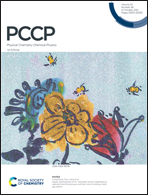Multipole-moment effects in ion–molecule reactions at low temperatures: part I – ion-dipole enhancement of the rate coefficients of the He+ + NH3 and He+ + ND3 reactions at collisional energies Ecoll/kB near 0 K
Abstract
The energy dependence of the rates of the reactions between He+ and ammonia (NY3, Y = {H,D}), forming NY2+, Y and He as well as NY+, Y2 and He, and the corresponding product branching ratios have been measured at low collision energies Ecoll between 0 and kB·40 K using a recently developed merged-beam technique [Allmendinger et al., ChemPhysChem, 2016, 17, 3596]. To avoid heating of the ions by stray electric fields, the reactions are observed within the large orbit of a highly excited Rydberg electron. A beam of He Rydberg atoms was merged with a supersonic beam of ammonia using a curved surface-electrode Rydberg–Stark deflector, which is also used for adjusting the final velocity of the He Rydberg atoms, and thus the collision energy. A collision-energy resolution of about 200 mK was reached at the lowest Ecoll values. The reaction rate coefficients exhibit a sharp increase at collision energies below ∼kB·5 K and pronounced deviations from Langevin-capture behaviour. The experimental results are interpreted in terms of an adiabatic capture model describing the rotational-state-dependent orientation of the ammonia molecules by the electric field of the He+ atom. The model faithfully describes the experimental observations and enables the identification of three classes of |JKMp〉 rotational states of the ammonia molecules showing different low-energy capture behaviour: (A) high-field-seeking states with |KM| ≥ 1 correlating to the lower component of the umbrella-motion tunnelling doublet at low fields. These states undergo a negative linear Stark shift, which leads to strongly enhanced rate coefficients; (B) high-field-seeking states subject to a quadratic Stark shift at low fields and which exhibit only weak rate enhancements; and (C) low-field-seeking states with |KM| ≥ 1. These states exhibit a positive Stark shift at low fields, which completely suppresses the reactions at low collision energies. Marked differences in the low-energy reactivity of NH3 and ND3—the rate enhancements in ND3 are more pronounced than in NH3—are quantitatively explained by the model. They result from the reduced magnitudes of the tunnelling splitting and rotational intervals in ND3 and the different occupations of the rotational levels in the supersonic beam caused by the different nuclear-spin statistical weights. Thermal capture rate constants are derived from the model for the temperature range between 0 and 10 K relevant for astrochemistry. Comparison of the calculated thermal capture rate coefficients with the absolute reaction rates measured above 27 K by Marquette et al. (Chem. Phys. Lett., 1985, 122, 431) suggests that only 40% of the close collisions are reactive.

- This article is part of the themed collection: 2021 PCCP HOT Articles


 Please wait while we load your content...
Please wait while we load your content...